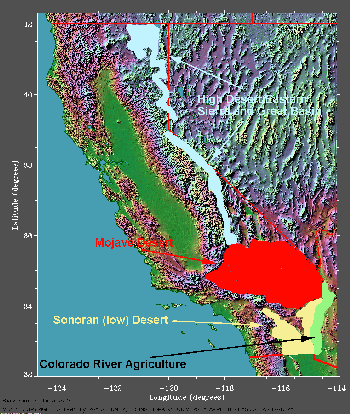 Deserts
DesertsThe important deserts of California are the high-desert regions such as Owens Valley, the intermediate deserts such as the Mojave, and the low Sonoran Desert of the southeastern portion of the state. These are all arid regions, with very little annual rainfall, and very high summer heat extremes. Grasses are much less common as a ground cover; creosote, rabbit brush, and many species of sage brush are the standard ground cover. Diverse seed- and insect-eating birds, rabbits, quail, and various species of rodent are common here, including snakes and lizards. In the upland areas, smaller evergreens (junipers and pinyon pines) prosper; in the lower deserts, mesquites and agaves occur. All of these provide unique and useful food sources to humans and other animals. There is one unique ecological community to be found along the eastern boundary of the state's southeastern desert; this is created by the presence of the Colorado River. The Colorado delivers so large an amount of water to this desert environment that it can support an unusual community of flora and fauna, quite different from other deserts and dramatically different from the rest of the Sonoran Desert. In fact, Native Americans who lived along the Colorado acquired skills as farmers, like other Southwestern people, and cultivated a variety of plants, by irrigation, that offered a staple food supply.
Return to previous page.